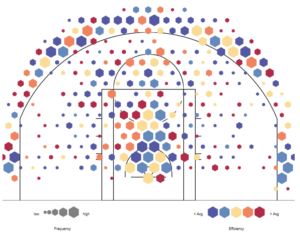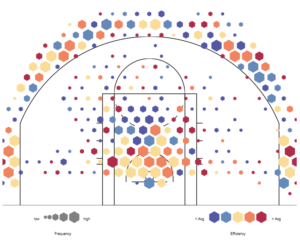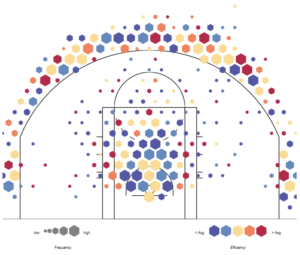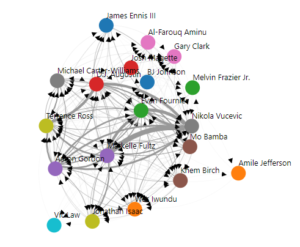Recent news marked back-to-back offseasons in which Russell Westbrook has requested a trade from his team. The results that followed last year’s trade, which sent him to the Houston Rockets, has brought Westbrook’s trade value to its lowest point in years. His new team finished the regular season with a +3.1 SRS, a significant decrease from its +5.0 mark the season before. The big takeaway from Westbrook’s tie in Houston was that he’s one of the least “scalable” players in the league. Perhaps this was overstated due to playing alongside James Harden, another ball-dominant offensive superstar, who was in the 99th percentile in average seconds per touch according to Second Spectrum. But a theme remained clear: it’s becoming much harder for Westbrook to impact better and better teams while his conflicting playstyle is intact. Evidently, the likely trade suitors for him are poorer teams. Names include the Knicks (-6.7 SRS), Pistons (-4.4 SRS), Hornets (-7 SRS), and Magic (-0.9 SRS). Would a trade to any of these teams make sense?
Most likely, yes. Westbrook is still a very good player, but as mentioned earlier, his playstyle could possibly be a hindrance to a great team trying to win a title. So it makes a lot of sense to send Westbrook to a mediocre or a poor team. Not only would Westbrook get to operate under more ideal circumstances, but a team would get a highly-effective offensive player to improve its performance. Houston was an extreme case of his low portability; the squad’s offense was nearly 3.5 points per 100 more-efficient with Westbrook off the floor. But on a team like Charlotte or Detroit, away from an environment that could create such a change, he could look something like his former self. He likely wouldn’t contend for another MVP Award, but Westbrook could help a mediocre team into Playoff contention. That leaves us with the question of the day: which teams make the most sense for Westbrook, and how exactly would he impact those teams?
—
New York Knicks
Westbrook’s name had been associated with the Knicks even before his trade request, and given the abysmal state of the team’s offense, the acquisition of Westbrook could help lift New York to near-adequacy on that end. However, the team has a fairly large problem: floor inefficiency. My study on the Eastern Conference Finals last season suggested effective field-goal percentage was the most indicative of team performance among Dean Oliver’s four factors, and the Knicks certainly corroborated it.

PBPStats
Even without percentages, it was clear the Knicks had a lot of cold spots on the floor. A part of it was likely their shot locations. New York hasn’t yet evolved grown into the modern archetype of a three-point barrage, let alone even an average frequency. The team was very close to the lowest three-point shot frequency in the league last season, trailing the Spurs and Pacers by a mere 0.01 points. This is likely due to the Knicks’ stagnant growth in the spacing category. My spacing metric argues New York’s offense was more clogged in 2020 than it was eleven seasons ago, an obvious sign of limited offensive growth. This would likely worsen the impact Westbrook could make in the Knicks’ offense. The team had the fourth-highest shot frequency from within three feet of the basket, and Westbrook led the league in drives per game last season. With the paint already clogged, it would be harder for Westbrook’s scoring to be effective: as evident from his scoring rate in Houston, which improved by 5.4 points per 100 on the most spaced-out team in the league.
It could be argued that a more clogged offense would promote shot selections elsewhere, but Westbrook isn’t very effective anywhere else. Relative to league average, within three feet of the basket is his most efficient range, and even then he’s below the norm. This is an especially negative sign considering he had the most efficient season from the floor in his career last year. So he fits the theme of inefficient scoring in New York, and that’s mostly a bad thing. The Knicks had a 50.1 eFG% last season, and Westbrook’s 49.3% wouldn’t exactly raise that figure without help from teammates. But another shooting range to consider is the perimeter. Could Westbrook boost the team’s distance shooting en route to a more efficient offense? Likely not. His frequency from deep was lower than it has been in nine years, posting a 3PAr+ of 43. Paired with weak efficiency (72 3P+), Westbrook’s shooting would not push the boundaries of the Knicks’ offense any further than its current state.
However, there is a strong chance Westbrook could make a positive impact through his passing. If we ballpark his value as a passer, we can come up with an idea as to how he’d raise the ceiling of the Knicks’ offense. By taking the number of points created by Westbrook’s assists and considering the frequency at which he passed the ball, we can estimate he created 0.43 points per pass. But that doesn’t account for the shooting strengths of his teammates. Excluding Westbrook, the Rockets had a 54.8 eFG% last season, which was significantly higher than the league-average of 52.9%. Therefore, prorated to an average team, Westbrook would create around 0.416 points per pass. This is notably higher than the Knicks’ passing production, which clocked in at roughly 0.189 points per pass, one of the worst marks in the league. As the primary faciliatory, Westbrook would provide the most valuable with his passing and playmaking, both of which were understated alongside James Harden last season.
If Westbrook were traded to the Knicks, there’s a mildly clear preliminary picture as to how he’d impact the team. He doesn’t help them on a lot of fronts including efficiency from the field and shot selection. Westbrook’s scoring would likely suffer due to a more clogged paint, but playing alongside the most ball-dominant scorer of the decade may have understated his scoring rate last season. Therefore, it’s not unreasonable to say Westbrook’s floor efficiency would decline while his scoring rate would remain stagnant. He doesn’t push the boundaries of distance scoring, and he would only mildly increase points through free-throw efficiency (76.3% last season versus the Knicks’ 69.4% as a team). But Westbrook’s passing would be a wild card. He could either push the limits and lift the Knick’s offensive rating to, say, 109 if the league-average hovers around 111, but that number could be as low as 107.5 if increasing age and emphasized weaknesses play larger roles. I’d estimate Westbrook would raise the Knicks’ offense to a middle-ground number, roughly 108 rounded to the nearest whole. The relative offense would range from around -2.5 to -3.5 points depending on the development of Westbrook’s new teammates.
—
Detroit Pistons
The Pistons are in a similar boat as the Knicks: a poor team without a clear anchor. But the good is news is that Detroit is notably better than the Knicks. The Pistons’ offense was -1.6 points worse than average compared to the Knick’s -4.1 relative offense. They’re still a net-negative team (-4.5 SRS), but Westbrook is given much more to work with. He just may be the last push the Pistons need to set forth a solid offense next season.

PBPStats
Detroit boasts more selective shot locations than those of the Knicks, with an apparent decrease in mid-range shots and higher frequencies in the two most efficient ranges: the paint and the perimeter. The Pistons were smack in the middle of three-point frequency last season, 15th among teams, at 38.1 three-point attempts per 100 field-goal attempts. Furthermore, the paint is far less clogged in Detroit than it is in New York, the former squad taking 3.1% fewer of their shots from within three feet of the hoop. My aforementioned spacing metric corroborates this. Detroit wasn’t necessarily a team with exceptional spacing, ranking 22nd among teams, but it’s a more desirable situation than the Knicks considering the information we’ve gone over. The positioning of Westbrook’s teammates would likely give him more room to do damage on usage possessions as well as target teammates more effectively than if he were operating in the Knicks’ offense.
While Detroit seems to be a great place for Westbrook to revitalize his role as “the man” on a solid offense, can we confidently say he’d push the boundaries of that offense? The Pistons were dead-average in terms of floor efficiency, posting a 52.9 eFG% last season; Westbrook’s poor floor efficiency wouldn’t exactly improve that figure if he were on the team. They were one of the worst teams at limiting turnovers; Westbrook fell outside the interquartile range in adjusted turnover percentage, which couples a player’s turnover rate with how often he’s involved in the offense to level the playing field for high-usage creators. Conversely, there are two factors for which he could provide a subtle boost. Detroit was above league-average in free-throw rate, but given the average floor efficiency of the team, it’s clear last year’s offense had some form of untapped potential. Westbrook accounts for three free-throw attempts every ten field-goal attempts, a rate that was actually understated last season in Houston due to his teammates’ spacing (which equals more defenders on the perimeter and fewer in the paint, a mixture that took away Westbrook’s odds of getting the opposition into foul trouble).
The last time Westbrook was “the man” on a team, he was accounting for four free-throw attempts per ten field-goal attempts, and given Detroit’s lack of excess spacing, Westbrook’s foul-drawing skills would be maximized as a Piston. There’s also his status as an offensive rebounder. Westbrook remains one of the elite rebounding guards in the league, grabbing 5.1% of available offensive boards last season. Detroit had a +0.1 relative offensive rebounding percentage last season, but a decent chunk of that success was due to 48 games of Andre Drummond, the elite rebounder who grabbed 15.3% of available offensive rebounds as a member of the Pistons last year. Given the state of Detroit’s roster going into next season, it’s not unreasonable to suspect the team falls below average as offensive rebounders. Westbrook’s proficiency in that aspect would, although not drastically, raise the ceiling for a team like Detroit. They were 21st in field-goal attempts per 100 possessions among teams last season, so to give the Pistons a greater chance at taking some of those shooting possessions back, more offensive rebounding could provide a notable uptick in offensive rating without having to bring in other elite talents.
Right off the bat, I’d predict Westbrook’s fit as a Detroit Pistons surpasses that as a New York Knick. He gains the right amount of spacing for more room to operate without limiting his free-throw rate as an expense. Westbrook gives more boosts to Detroit’s offensive profile as an offensive rebounder, a free-throw scorer, and as a passer (nearly twice as many assist points created per pass as the Pistons team). We could reasonably expect jumps in scoring rate, due to a more significant role and a strong scoring environment as a member of the Pistons, and assist rate, due to his role as the primary distributor and with teammates of higher floor efficiency than those in New York. Therefore, if I were responsible for trading Westbrook to either Detroit or New York, I would trade him to Detroit. His low scalability wouldn’t be dramatically exploited alongside the teammates he’d have, retaining his stronger offensive impacts in more neutral environments. The Pistons’ offense also showed to be signaling greater potential, and given the impact Westbrook can make on a team of Detroit’s caliber, it’s not unreasonable to argue the Great Lakes State is the optimal suitor for him. We could see a similar increase in offensive rating to that of New York, but with a higher ceiling due to a more suitable situation. Detroit’s offense in 2020, with Westbrook, could be as low as 110 and as high as 112, or a -0.5 to +1 relative offense.
—
Charlotte Hornets
Similar to New York, Charlotte has been thought of as one of the most likely destinations for Westbrook: a team that’s struggling to compete for a Playoff seed without their franchise great, Kemba Walker. There are different ideas on how the acquisition of Westbrook fits the Hornets’ timetable. Are they putting their future on hold taking the burden of Westbrook’s contract and his heavier ball-dominance, or does putting an All-Star on the roster help raise the team’s possibilities? These viewpoints will vary, but it’s hard to deny the attention the media has paid to a potential trade.

PBPStats
The Hornets’ shot locations reveal what sets them apart from the two previous teams: spacing. The Knicks provided little to none, and although Detroit was a mild improvement, Charlotte is nearly touching league-average in the spacing metric I cited in the two earlier segments. With three players in the starting lineup with above-average three-point capabilities in Devonte’ Graham, Terry Rozier, and P.J. Washington, Westbrook is granted more than enough space to make a major offensive impact. For reference, his 2017 MVP campaign was done in an environment where defenses reacted “negatively” to the OKC offense, moving inward from the three-point line and toward the paint at an 0.069 increment, or approximately 6.9% closer to the paint relative to the three-point line. Meanwhile, the Hornets had a -0.007 “relative” Spacing. This also gives Westbrook enough defenders in the post to revitalize his more potent free-throw rates.
Given the on-court structures of the offenses we’ve examined so far, I’d say Charlotte is the best environment for Westbrook to unleash the most of his potential impact. But how do the “goodness” and tendencies of that offense further give Westbrook chances to make a strong improvement in the Hornets’ offensive efficiency? For one, the Hornets are an extremely poor-shooting team from the field, nearly descending to Westbrook levels (50.4 eFG%). This is an area he wouldn’t exactly bolster, but one he’s good enough in that he won’t diminish his teammates’ efforts. A skill in which Westbrook is more of a “middle ground” is three-point frequency. Charlotte had a +0.015 “relative” three-point frequency, hitting them at a 35.2% clip, a few points below league average. Westbrook certainly doesn’t improve these figures with his own efforts, but his stronger role on the team would likely increase the production of his teammates, creating more open and more efficient looks when defenses are scrambling to find Westbrook in the post. As he would the majority of all the offenses we’ll look at, he’d improve Charlotte’s efforts from the charity stripe, but this time at a higher frequency and efficiency. Westbrook gets to and scores from the line at higher rates than the cumulative team results last season.
This seems to be a very good option for Westbrook in terms of how his skills would impact the team, but how would he raise the team’s offensive rating and put them in a better position to compete for a Playoff seed? For one, Charlotte had one of the worst offenses in the league last season, posting a -4.3 relative offensive rating, even worse than the Knicks’ efficiency I cited earlier on. It was a mark only the Warriors, a team deprived of offense due to injuries, fell under last year. This isn’t exactly a surprise; the Hornets didn’t have a true offensive anchor with Graham and Rozier running the show, or the strong bench pieces to pick up some of the slack. Therefore, Charlotte would likely be a much better team with Westbrook on the floor given their lack of offensive talent. Westbrook’s fit in the Hornets’ environment and the weaker state of the team lead me to believe he’d mesh better with teammates there than in New York while also providing more offensive value. Next to Detroit, it’s even more clear that Charlotte is in greater need of Westbrook’s impact than one of the more effective offenses in the league, especially one with a returning Blake Griffin. Westbrook’s role in the Hornets’ environment surpasses those of the Knicks or Pistons, but exactly how much better does he make Charlotte? If his efforts in 2021 result in either a low Playoff seed (unlikely) or a few SRS points higher than last season, are his talents really being put to use?
Earlier, I estimated that Westbrook could provide a rough offensive impact of +0.5 to +1.5 points per 100, and that number would likely hold on a team of similar caliber in Charlotte. But this time, Westbrook’s in a more desirable situation with a more appropriate fit, so how does that value change? The Hornets’ offense is poor enough that I wouldn’t expect an offensive rating above 108 barring any significant teammate improvements. However, I think the floor for Westbrook’s value in Charlotte is also much higher. I’d estimate an offensive efficiency of 107 points per 100 if age starts catching up to Russ and his bandmates plateau. Therefore, I think a trade to Charlotte is the more desirable choice compared to New York, but Detroit is an interesting case. Detroit gives Westbrook the opportunity to anchor a stronger offense without having to pressure the diminishing returns in impact he experiences so often. If Detroit doesn’t improve on defense and Westbrook’s 50th percentile impact comes to play, they could play at a -1.5 SRS level, which would be just outside the Playoff picture for Eastern Conference teams this year. Given the probable improvements of several teams inside that picture like Brooklyn, as well as the ones were observed in teams like Boston and Miami, it’s reasonable to say (barring any major moves in the next few weeks) that the 50th percentile outcome for Detroit would be to miss the Playoffs. I’ll come back to further examine the ramifications of either trade later on.
—
Orlando Magic
Among rumored teams, Orlando was one of the first few to be identified as a potential suitor for Westbrook, and rightfully so. At a quick glance, the Magic are the most intriguing option for Westbrook because of their strong defense and an offense in need of a true engine. They were able to clinch a Playoff seed last season, and the current state of the East suggests they could do it again. Is this a match made in heaven or are there drawbacks to Westbrook potentially joining the Magic?

PBPStats
Orlando didn’t have very many creators on its team last season. D.J. Augustin was an adequate primary playmaker, having averaged 6.8 assists per 75 and creating around 7 shots for teammates per 100. Markelle Fultz, Evan Fournier, and Nikola Vučević created around 6, 6, and 5, respectively. But the Magic have yet to acquire a playmaker who can potentially take their offense over the top. Westbrook would’ve been the highest creator on the team despite heavily deflated playmaking numbers. His world-class passing would lift the team’s poor shooting (50.6 eFG%) while he could also make a positive impression with his own scoring. Westbrook’s capabilities as a half-court passer, especially into the post, would create an elite tandem with teammate Vučević, who had a strong gig going with Fultz until the season’s end. Orlando was nearly in the bottom 10% in shot frequency from within three feet of the hoop, and the upgrade from Westbrook’s interior playmaking would encourage both volume and a higher conversion rate in the sport’s most efficient zone.
Westbrook would round the edges of the Magic’s offense perhaps as well as he would any other. He’d tease minor leaps in free-throw frequency on pace for a +0.041 clip, likely an understatement due to his aforementioned leap in expected free-throw rate. Westbrook fits the mold of Orlando’s low-frequency style from deep, and likely wouldn’t hurt that aspect as much as he would other teams with greater frequencies. But his playmaking, the capabilities of which extend across the court, would improve the team’s efficiency from three as well. Westbrook likely wouldn’t raise the Magic’s three-point efficiency to league-average unless, say, they add some better shooters in the offseason, but the boost he’d give the current roster in this respect could potentially bring their offense to league-average levels. Aside from offensive rebounding, there is the fewest number of skills in which Westbrook’s impact would be of high magnitude, the inverse of several teams preceding the Magic on this list, but the improvements he could bring to their offensive efficiency are strong enough to deem his acquisition a win on the talent front rather than fit, or how he molds and redefines the team’s tendencies.
How would Westbrook raise the Magic’s odds to succeed? When we look back to an earlier sentiment, as to how Westbrook’s on-court impact could be an intriguing factor while a strong base behind him could limit the magnitude of his on-off splits, it’s hard to say exactly how much better Westbrook’s situation in Orlando would be than that of Charlotte or Detroit. The Magic’s strong defense and a potentially-average offense would lift them to the Playoffs almost certainly, but can we conclude Westbrook would be made the most use of? When it comes to a mixture of how he impacts the team and how the team could succeed, Orlando is the most desirable option of the four. Westbrook’s value may not be as high there as Charlotte, where he’d likely be of the most importance, but the possibility of a postseason berth would put his talents to more use. Westbrook isn’t exactly the smartest trade options given the Hornets’ current timetable. Therefore, Westbrook to Orlando would likely “make the most sense” for both him and the destination.
—
Notice how I haven’t considered Westbrook’s defense so far? That’s because it’s a “scalable” trait, one that’s rarely (if at all) affected by team circumstance. Based on last year’s performance, a rough estimate of Westbrook’s per-game defense impact would be -0.25 points. Based on this and the above analysis, how would Westbrook impact each team’s point differential and how would that translate to postseason hopes?
- NYK (108.3 ORtg | 112.5 DRtg) -4.2 Net
- DET (110.5 ORtg | 112.5 DRtg) -2 Net
- CHA (107.7 ORtg | 113.3 DRtg) -5.6 Net
- ORL (109.7 ORtg | 109 DRtg) +0.7 Net
Based on these estimates, Westbrook’s skills would really only be put to use on a team like Orlando, one that appears a desirable fit and one that promises the strongest odds of Playoff success.

Leave a Reply